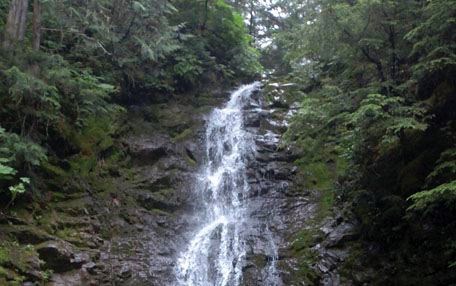There's an orchid thriving near the Ancient Forest waterfall that hasn't been seen in the B.C. interior since 1932.
It sits unassumingly among more than 400 different species of plant life discovered during the first day of field research done by a team from UNBC last week.
"We've started some exciting research this summer," said Darwyn Coxson, professor in the ecosystem science and management program at the University of Northern British Columbia. "We're working together with the Lheidli T'enneh on a project that will assess plant biodiversity in the new Ancient Forest Chun T'oh Wudujut provincial park."
It's an interesting area because the park encompasses habitats from the top of Driscoll Ridge down through sub-alpine forest into the ancient cedar stands and then below that there's a large diversity of different types of wetlands and then the park ends up by the Fraser River, said Coxson.
It's an impressive range of different habitats and most of them have not been visited by botanists up to this point in time, he added.
"So we don't have an idea of what might be found so it's a really a voyage of exploration finding out what's in our backyard in terms of plant species diversity," said Coxson.
Coxson is partnering with Curtis Bjork and Trevor Goward, both botanists that work out of Clearwater and are affiliated with the University of B.C. and the University of Idaho.
"They are specialists in rapid biodiversity assessment," said Coxson.
Bjork has taken UNBC students out to remote areas of the park and will continue to do so throughout the summer, Coxson added.
June 14 was the first day of field work and after a long afternoon Bjork and the students had found more than 400 plant species around the waterfall.
"Just an astonishing total," said Coxson. Bjork told Coxson that's a higher number than he has seen elsewhere in North America on a first day's survey in a new area.
"So this just blew our socks off after the very first day of field work."
In the days that followed, researchers found plant species they didn't know even existed in this area of the province, Coxson said.
Many plants discovered are red- or blue-listed by the B.C. government. A red-listed plant is on the verge of extinction and is only at one or two other sites in B.C. A blue-listed plant is threatened, which means it's rare and its habitats are in danger, explained Coxson.
Two examples of the rare plants that have been discovered at the Ancient Forest waterfall is the blue-listed bog adder's-mouth orchid and red-listed Joe-pye weed.
The bog adder's-mouth orchid had been seen at Aleza Lake in 1932 and hasn't been seen since.
"So we've rediscovered it in the Chun T'oh Wudujut park last week at the edge of a black spruce bog," said Coxson. "It really feels great finding it again."
The plants are documented by carefully photographing them and marking their locations.
"This will all be entered into the B.C. Conservation data centre's data base that will be updating the scientific information on these plants," said Coxson. "And there's probably another 20 species we've discovered in the last week."
The Joe-pye weed is a member of the astor family and it's a plant that's about six feet tall with big red flowers. There's only two other known populations of the plant in B.C. One location is only about 100 plants, considered endangered, at the mouth of the Fraser River and there's another small population in a wetland near Revelstoke.
"And now we have a third sighting in British Columbia," said Coxson. "And there are many more examples of these incredibly rare plants that we are finding in the new park so it really validates for us the decision to seek park status for the area and it's reassuring to know that these rare plants will have a protected home into the future."
But that's not all.
"This study is being done in context of a larger objective," said Coxson. "We're hoping to work with the Lheidli T'enneh towards a nomination of the Chun T'oh Wudujut provincial park as a World Heritage Site. So this documentation of many rare plants species within the park boundaries is very strong supporting information for a future World Heritage Site nomination."
A complete report of all the plant life found on site at the Ancient Forest will be available this winter. Putting the application in for the designation of a World Heritage Site is several years out but the information about the plants species will be a big part of the package, he said.



